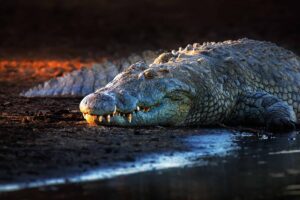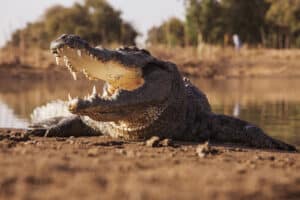The herd of wildebeest congregates around the water hole. A juvenile lowers its head to the water’s edge for a refreshing drink. Snap! In an instant, a crocodile, seemingly out of nowhere, lunges from the water and bites the wildebeest in the neck, dragging it into the water. The wildebeest fights back, trying to escape, but the strong jaw and fierce teeth of the crocodile hold tight. The crocodile holds the prey under the water and performs the death roll, rolling over multiple times to kill and dismember the struggling wildebeest. Let’s find out all about the crocodile death roll!
Why Do Crocodiles Death Roll?
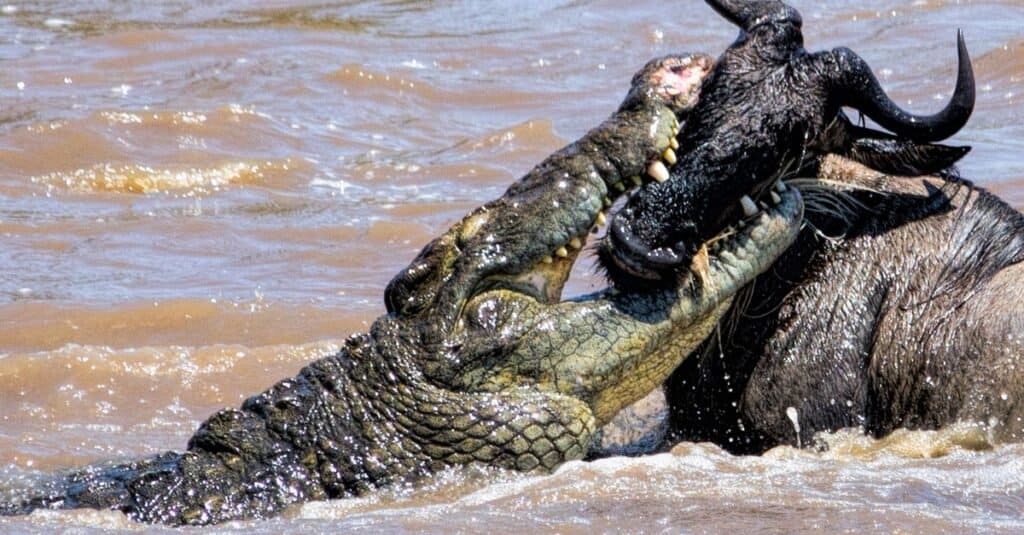
Crocodiles use the death roll to kill and dismember their prey!
©Phil Hyde/Shutterstock.com
- Crocodiles death roll to kill their prey, snapping their necks or holding them underwater to drown.
- Crocodiles death roll to dismember their prey and break it into smaller pieces. Chunks of the prey fall off and make it easier for the crocodiles to swallow. Crocodiles do not chew their food; they swallow big chunks whole.
- Crocodiles death roll to disorient their prey, making them dizzy so they can’t escape. The rotations of the death roll are incredibly fast, even with large prey. The prey is not only disoriented from the initial shock of being bit, but the added rotations can make them even more disoriented.
- Crocodiles death roll to show dominance towards other crocodiles. When crocodiles are defending their territory or competing for a mate, they will fight and use the death roll as a combat technique.
Does The Death Roll Make Crocodiles Dizzy?
If you’ve ever played Dizzy Bat, a relay game where you run down, put one end of a baseball bat on the ground and the other to your forehead, and spin around five times. When you try to run back to your teammates, you stagger all over and, most of the time, fall! The death roll creates the same sensation for the prey, making it disoriented and less likely to get away. Crocodiles seem to be unaffected by the dizzying effects, so it is such an effective technique.
Do All Crocodiles Death Roll?
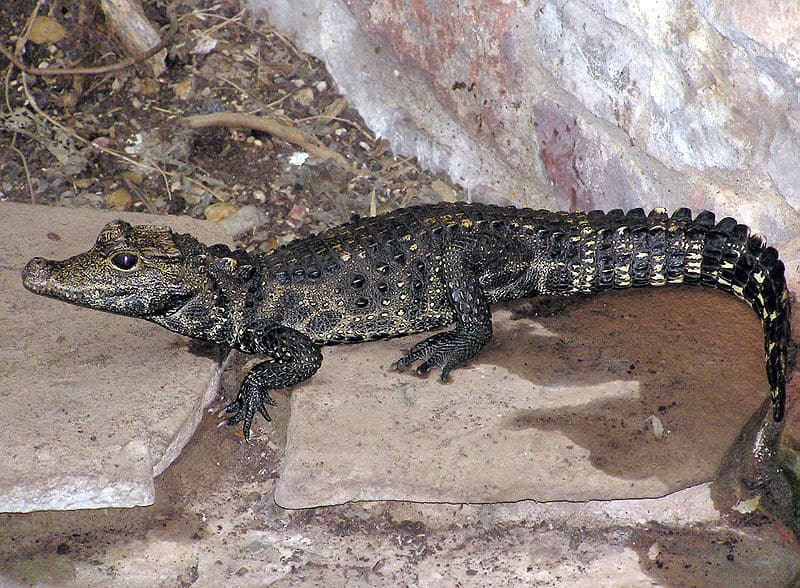
A recent research study showed that 24 of 25 crocodile species could death roll.
©Arpingstone, Public domain, via Wikimedia Commons – Original / License
All but one crocodile species death roll. In a research study by Stephanie Drumheller-Horton from the University of Tennessee, Knoxville, all 25 species of crocodile were studied at the St. Augustine Alligator Farm in Florida. Kent Vliet from the University of Florida assisted in the study to see if all of the crocodiles would death roll. The experiment results showed that 24 of the 25 species death rolled! The only species that did not was the Cuvier’s dwarf caiman, a small crocodile species from South America. The researchers admitted that just because the dwarf caiman didn’t death roll during the experiment doesn’t mean that it can’t. It is more likely that dwarf caimans death roll in the wild.
Do Crocodiles Use The Death Roll On Land Too?
Yes, crocodiles can death roll on land and in water. They spend most of their time in water or basking in the sun on the banks of rivers and waterways. They are equipped to walk and even run on land. Depending on the availability of food, crocodiles may need to hunt further from the water source and are equipped to death roll on land.
What Kinds Of Animals Are Prey To Crocodiles?
Crocodiles eat fish, crustaceans, frogs, lizards, and larger prey like zebra, wildebeest, and small hippos. Different crocodiles species are located in different ecosystems, so Nile crocodiles in Africa may eat zebras while the Saltwater crocodiles of Australia eat kangaroos. Crocodiles can snatch a low-flying bird out of the air as well!
Do Any Other Animals Death Roll?
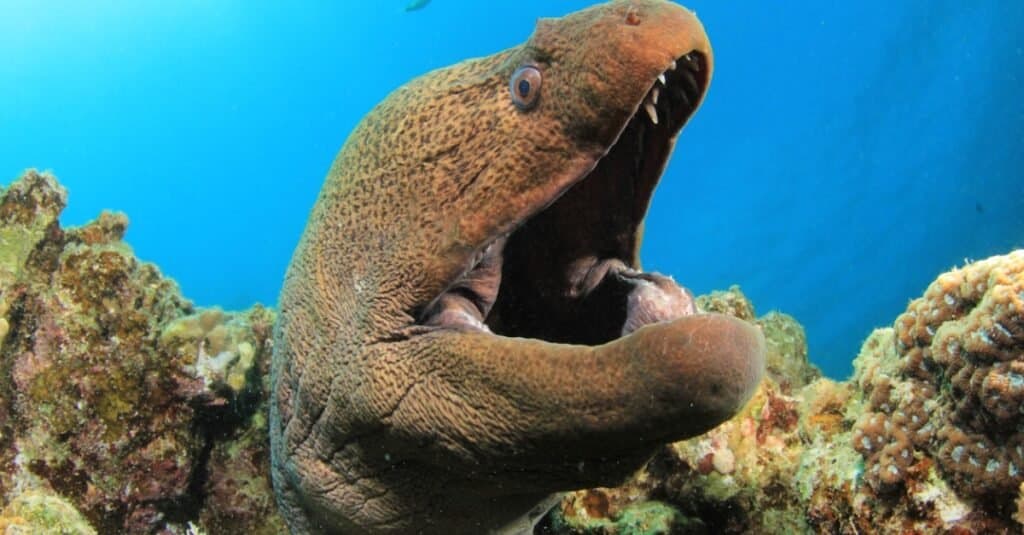
Moray eels are ambush predators like crocodiles. They also death roll their prey underwater.
©Rich Carey/Shutterstock.com
There are a few other animals that death roll. None are as spectacular as the crocodile, but a moray eel death rolling an octopus is a sight to see!
- Alligators
- Moray eels
- Mudpuppies
- Some salamanders
- Monitor lizards
- Pyjama sharks (small sharks that look like they are wearing striped pajamas!)
Can Humans Be Death Rolled By Crocodiles?
Yes, crocodiles treat humans like any other prey. In some remote areas of countries in Africa and India, crocodile attacks are a real threat to human life. When there is a large number of people using the same water source as a large population of crocodiles, there is an increased chance of crocodile-human conflicts. Nile crocodiles live in most countries in Africa, and saltwater crocodiles inhabit India and Australia. These large, aggressive crocodiles can grow to be 20 feet long! It is estimated that there are 1,000 fatalities a year from crocodile attacks. The number is probably much higher due to unreported cases.
A tourist in the Philippines was lucky he escaped before a Philippine crocodile tried to death roll on him. He was visiting the Amaya View Amusement Park in Cagayan de Oro City, the Philippines, with his family when he climbed into a pool with a 12-foot crocodile to take a selfie. He thought the crocodile was a statue like a cement tortoise nearby. The crocodile grabbed the man’s arm with its jaws and dragged him into the water. The man was able to escape, but his arm was badly injured. He was transported to the nearest hospital, where he received treatment. It was a scary event, but it is good that he got away before the death roll.
Do Baby Crocodiles Death Roll?

Baby crocodiles are capable of death rolling too.
©Marc Pletcher/Shutterstock.com
Yes, baby crocodiles can death roll. A cute video is circulating from a Louisiana pond where a group of baby alligators is eating fish scraps. One of the gators rolls repeatedly, showing off to his friends. Perhaps it is instinctual, or maybe they learn from watching their mothers, but either way, the footage is not as impressive as a 15-foot Nile crocodile rolling a 300lb wildebeest!
The photo featured at the top of this post is © Sergey Uryadnikov/Shutterstock.com
Thank you for reading! Have some feedback for us? Contact the AZ Animals editorial team.





